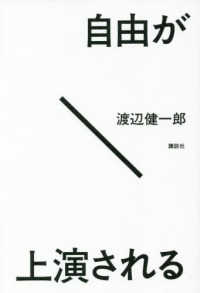Full Description
"As a writing teacher for twenty-some years, I wish I'd had access to this material."
-Marilee Sprenger, Educational Consultant
Seattle Pacific University
"Helps teachers see how to approach writing in ways that make it fresh, relevant, and accessible."
-Carol Ann Tomlinson, Professor of Educational Leadership
University of Virginia
"True to one of the basic tenets of writing, the book shows rather than tells . . . . This makes for a fun and engaging read."
-Erin Sullivan, Research Associate
University of Connecticut
Are your picture-smart, music-smart, and body-smart learners lagging behind their word-smart and number-smart peers?
Donovan Walling offers innovative new ways to help these learners become effective writers! With an emphasis on matching teaching method to learning style and developing both basic writing competencies and higher-level thinking skills, this resource offers instructional strategies, sample lessons, and pathways to fluency that focus on
Organizing ideas "artistically"
Using walkabout strategies to clarify concepts
Using pattern and rhythm for writing sense, and much more
Twelve sample lessons and a learning styles self-assessment make this an essential resource for teachers, literacy coaches, and curriculum designers who want to expand writing curriculum and incorporate more non-linear methods into their instructional repertoires.
Contents
Acknowledgments
About the Author
Introduction
1. Writing Processes and Differentiated Instruction
Assembly-Line Writing
Teaching Writing for Meaning
Learning Styles and Differentiated Instruction
Stimulus, Process, and Product
Learning Styles Self-Assessment
References
2. Writing About Real Things
School Writing Versus Authentic Writing
Multidimensional Authentic Response Writing
And Then: The Process Phase
Pathways to Fluency
Sample Lesson 2.1: Respond As a ___ Might
Sample Lesson 2.2: Multidimensional Authentic Response Writing
References
3. Observing, Then Writing
Sensory Reportage
Visual Reportage
Auditory Reportage
Kinesthetic Reportage
Translation Into Different Forms
Sense Exploration
Writing Up the Taxonomy
Sample Lesson 3.1: Template and Checklist Strategies
Sample Lesson 3.2: Observation and Sensory Reportage
References
4. Organizing Artistically
Pearls-on-a-String Organization
Inductive and Deductive Organization
Inverted Pyramid Organization
Identifying Key Ideas
Another Translation: Factual Reportage
Sample Lesson 4.1: Gathering and Organizing Information
Sample Lesson 4.2: Artistic Organization
5. Clarifying Ideas Using Walkabout Strategies
Walkabouts
Paragraph Walkabouts
Auditory and Kinesthetic Paragraph Walkabouts
Collaborative Planning, Drafting, and Revising
Guide on the Side
Sample Lesson 5.1: Paragraph Walkabout and Sense Exploration
Sample Lesson 5.2: Paragraph Walkabout Analysis
6. Using Patterns and Rhythms for Writing Sense
Discerning and Adjusting Patterns and Rhythms
Translating the Visual and the Auditory for Kinesthetic Learning
Brevity, Elaboration, and Conceptual Density
Outlining to Revise
Sample Lesson 6.1: Outlining to Revise — and Revising
Sample Lesson 6.2: Patterns and Rhythms for Writing Sense
7. Choosing the Right Words
Basic Words: Nouns and Verbs
Correct and Politically Correct
More Basic Words: Adjectives and Adverbs
Brevity
Spelling Improvement
Sample Lesson 7.1: Reviewing the Words
Sample Lesson 7.2: Up Close: Choosing the Right Words
References
8. Increasing Focused Engagement
Selective Correction
The Importance of Portfolios
Making and Using Rubrics
Rubrics and the SAT Essay
Concluding Thoughts and a Final Checklist
References
Resources
Print
Online
Index








